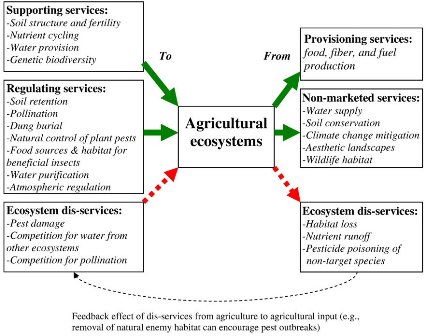Ecological Goods and Services and Natural Capital
What are Ecological Goods and Services and Natural Capital?
Ecological goods and services (EG&S) are the environmental benefits resulting from physical, chemical and biological functions of healthy ecosystems and include market goods produced from ecosystems (ex: food, fibre, fuel, fresh water, genetic resources, etc.), the benefits from ecosystem processes, (ex: nutrient cycling, climate regulation, water purification, waste treatment, pollination, etc.) and non-material benefits (ex: aesthetic values, recreation, etc.). Dis-services, such as loss of wildlife habitat and biodiversity, can impair the production of EG&S.
Natural capital includes the natural environment and ecosystem resources, such as soils, forests and wetlands that provide environmental assets and services essential to life. Natural capital is similar to the concept of economic capital in that it provides a continued flow of EG&S. Natural capital is composed of natural resource capital (ex: minerals, energy, forests), land (ex: where human activities occur) and ecosystems or environmental capital (ex: waste assimilation by wetlands).
Examples of Natural Capital and the EG&S Provided
| Natural Capital | Ecological Goods and Services Provided |
| Forests | Carbon sequestration, soil formation, waste treatment, biological control, cultural, air quality, stormwater control, recreation, raw material (timber), genetic resources |
| Grasslands, rangelands | Carbon sequestration, water regulation, erosion control, soil formation, waste treatment, pollination, biological control, food production |
| Wetlands | Disturbance regulation, water supply and treatment, carbon sequestration, food production, recreation, cultural habitat/refuge |
| Lakes, rivers, riparian zones | Water supply, waste treatment, food production, recreation |
| Croplands | Food production, habitat/refuge, scenic |
| Undeveloped lands | Scenic |
Source: The Value of Natural Capital in Settled Areas of Canada (PDF 680 KB) (Olewiler, 2004)
Economic Value of EG&S
Globally, natural capital and EG&S has been declining continually as landscapes are converted from their natural states for human use. Manitoba continues to lose natural capital from agricultural lands. Unsustainable depletion of natural capital results in the reduction of EG&S that can be provided. These losses may cost society more than the original value of the natural capital destroyed, as replacing the services can be much more expensive than what is typically provided by nature.
Investing in the maintenance of natural lands on privately owned farmlands and Crown Land is a way for society to encourage the continued provision of EG&S. Well-managed agricultural lands provide benefits to society-at-large.
Agriculture is both a beneficiary and a provider of EG&S (see Figure 1). For example, farming's viability depends on ecosystem processes like soil renewal, climate regulation and precipitation. At the same time, well-managed agricultural lands can provide benefits to broader society that include fish and wildlife habitat, scenic views, and purification of air and water through natural processes.
Figure 1. Ecosystem Services and Dis-Services From Agriculture

Source: Zhang, W., Rickets, T., Kremen, C., Carney, K., Swinton, S. (2007). Ecosystem services and dis-services to agriculture. Ecological Economics, 64: 253-260.
Land owners/managers have the opportunity to ensure EG&S is being provided by their lands by maintaining or enhancing wetlands, riparian areas, natural uplands and ecologically sensitive lands. Investments for the continued provision of EG&S on agricultural land is one method of ensuring the contributions to human well-being provided by ecosystems can be sustained and enhanced. Other measures include transfer of knowledge through extension and regulations.
Manitoba is continuing to investigate the role of the EG&S concept in the development of future agri-environment policy through the development of the Manitoba EG&S Initiative Working Group.

